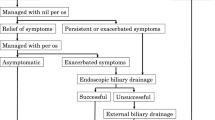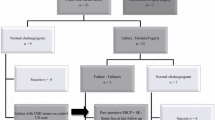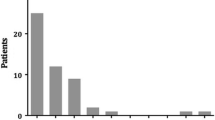Abstract
Aim/Materials and Methods Between January 2000 and June 2007, 3,548 endoscopic retrograde cholangiopancreatography (ERCP) were performed for extrahepatic cholestasis, cholangitis, and choledocholithiasis. The results of ERCPs were evaluated retrospectively and examined carefully to investigate the management and endoscopic therapy of biliary parasites. Results Of the 3,548 patients who underwent ERCP, 24 (0.66%) were found to have biliary parasitosis. The mean age of the biliary parasitosis patients (16 women) was 48.6 (15–77) years. Of these 24 cases, 16 patients had hydatid cystic disease (eight with partial obstruction of the biliary tract, and eight with ruptured cysts), four patients had Fasciola hepatica, and four patients had Ascaris lumbricoides infestation. Endoscopic sphincterotomy was performed, after which the choledochus was examined carefully by balloon catheter and basket procedure. Conclusion The ERCP procedure is very useful in the therapy of biliary parasitic infestations.



Similar content being viewed by others
References
Osman M, Lausten SB, El-Sefi T, et al. Biliary parasites. Dig Surg. 1998;15:287–296. doi:10.1159/000018640.
Philips RD, Yung YH. Surgical helminthiasis of the biliary tract. Ann Surg. 1960;152:905–910. doi:10.1097/00000658-196011000-00020.
Yellin AE, Donovan AJ. Biliary lithiasis and helminthiasis. Am J Surg. 1981;142:128–136. doi:10.1016/S0002-9610(81)80022-0.
Schulman A. Non-Western patterns of biliary stones and the role of ascariasis. Radiology. 1987;161:425–430.
Choi TK, Wong U. Severe acute pancreatitis caused by parasites in the common bile duct. J Trop Med Hyg. 1984;87:211–214.
Van Severen M, Lengele B, Dureuil J, et al. Hepatic ascaridiasis. Endoscopy. 1987;19:140–142. doi:10.1055/s-2007-1018261.
Purtilo DT. Clonorchiasis and hepatic neoplasms. Trop Geogr Med. 1976;28:21–27.
Gharbi HA, Hassine W, Brauner MW, et al. Ultrasound examination of the hydatic liver. Radiology. 1981;139:459–463.
Czermak BV, Akhan O, Hiemetzberger R, et al. Echinococcosis of the liver. Abdom Imaging. 2008;33:133–143. doi:10.1007/s00261-007-9331-0.
Pedrosa I, Saíz A, Arrazola J, et al. Hydatid disease: radiologic and pathologic features and complications. Radiographics. 2000;20:795–817.
Fitoz S, Atasoy C. MR cholangiography in massive hepatobiliary ascariasis. A case report. Acta Radiol. 2000;41:273–274. doi:10.1080/028418500127345235.
Das CJ, Kumar J, Debnath J, et al. Imaging of ascariasis. Australas Radiol. 2007;51:500–506. doi:10.1111/j.1440-1673.2007.01887.x.
Benedetti NJ, Desser TS, Jeffrey RB. Imaging of hepatic infections. Ultrasound Q. 2008;24:267–278. doi:10.1097/RUQ.0b013e31818e5981.
Kumar R, Reddy SN, Thulkar S. Intrabiliary rupture of hydatid cyst: diagnosis with MRI and hepatobiliary isotope study. Br J Radiol. 2002;75:271–274.
Bonakdarpour A. Echinococcus disease. Report of 112 cases from Iran and a review of 611 cases from the United States. Am J Roentgenol Radium Ther Nucl Med. 1967;99:660–667.
Eyal I, Zveibil F, Stamler B. Anaphylactic shock due to rupture of a hepatic hydatid cyst into a pericystic blood vessel following blunt abdominal trauma. J Pediatr Surg. 1991;26:217–218. doi:10.1016/0022-3468(91)90916-H.
Wu X, Xin W, Zhao SY. Thirty-seven patients with hepatic hydatid cyst rupturing into choledochus. ZhonghuaWaiKeZaZhi. (Chinese abstract). 1997;35:279–280.
Vignote ML, Mino G, de la Mata M, et al. Endoscopic sphincterotomy in hepatic hydatid disease open to the biliary tree. Br J Surg. 1990;77:30–31. doi:10.1002/bjs.1800770110.
Ormeci N, Kir M, Coban S, et al. The usefulness of endoscopic retrograde cholangiopancreatography and (99 m)Tc-labeled albumin macroaggregates in diagnosing hydatid disease fistulae. Dig Dis Sci. 2007;52:1410–1414. doi:10.1007/s10620-006-9627-x.
Demirci S, Eraslan S, Anadol E, et al. Comparison of the results of different surgical techniques in the management of hydatid cysts of the liver. World J Surg. 1989;13:88–91. doi:10.1007/BF01671161.
Safioleas M, Misiakos EP, Kakisis J, et al. Surgical treatment of human echinococcosis. Int Surg. 2000;85:358–365.
Franchi C, Di Vico B, Teggi A. Long-term evaluation of patients with hydatidosis treated with benzimidazole carbamates. Clin Infect Dis. 1999;29:304–309. doi:10.1086/520205.
Saimot AG. Medical treatment of liver hydatidosis. World J Surg. 2001;25:15–20. doi:10.1007/s002680020003.
Khuroo MS, Zargar SA, Mahajan R. Echinococcus granulosus cysts in the liver: management with percutaneous drainage. Radiology. 1991;180:141–145.
Men S, Hekimoglu B, Yucesoy C, et al. Percutaneous treatment of hepatic hydatid cysts: an alternative to surgery. AJR Am J Roentgenol. 1999;172:83–89.
Pelaez V, Kugler C, Correa D, et al. PAIR as percutaneous treatment of hydatid liver cysts. Acta Trop. 2000;75:197–202. doi:10.1016/S0001-706X(00)00058-9.
Schipper HG, Lameris JS, van Delden OM, et al. Percutaneous evacuation (PEVAC) of multivesicular echinococcal cysts with or without cystobiliary fistulas which contain non-drainable material: first results of a modified PAIR method. Gut. 2002;50:718–723. doi:10.1136/gut.50.5.718.
Ormeci N, Soykan I, Bektas A, et al. A new percutaneous approach for the treatment of hydatid cysts of the liver. Am J Gastroenterol. 2001;96:2225–2230.
Han JK, Choi BI, Cho JM, et al. Radiologic findings of human fascioliasis. Abdom Imaging. 1993;18:261–264. doi:10.1007/BF00198118.
Takeyama N, Okumura N, Sakai Y, et al. Computed tomography findings of hepatic lesions in human fascioliasis: report of two cases. Am J Gastroenterol. 1986;81:1078–1081.
Cosme A, Ojeda E, Cilla G, et al. Fasciola hepatica. Study of a series of 37 patients. Gastroenterol Hepatol. (Spanish abstract). 2001;24:375–380.
Sezgin O, Altintas YE, Disibeyaz S, et al. Hepatobiliary fascioliasis: clinical and radiologic features and endoscopic management. J Clin Gastroenterol. 2004;38:285–291. doi:10.1097/00004836-200403000-00017.
Gulsen MT, Savas MC, Koruk M, et al. Fascioliasis: a report of five cases presenting with common bile duct obstruction. Neth J Med. 2006;64:17–19.
Sandouk F, Haffar S, Zada MM, et al. Pancreatic-biliary ascariasis: experience of 300 cases. Am J Gastroenterol. 1997;92:2264–2267.
Wani NA, Shah OJ, Naqash SH. Postoperative biliary ascariasis: presentation and management–experience. World J Surg. 2000;24:1143–1145. doi:10.1007/s002680010187.
Kubaska SM, Chew FS. Biliary ascariasis. AJR. 1997;169:492.
Hwang CM, Kim TK, Ha HK, et al. Biliary ascariasis: MR cholangiography findings in two cases. Korean J Radiol. 2001;2:175–178.
Khuroo MS. Hepatobiliary and pancreatic ascariasis. Indian J Gastroenterol. 2001;20:28–32.
Khuroo MS, Zargar SA, Yattoo GN, et al. Worm extraction and biliary drainage in hepatobiliary and pancreatic ascariasis. Gastrointest Endosc. 1993;39:680–685. doi:10.1016/S0016-5107(93)70222-9.
Alam S, Mustafa G, Ahmad N, et al. Presentation and endoscopic management of biliary ascariasis. Southeast Asian J Trop Med Public Health. 2007;38:631–635.
Author information
Authors and Affiliations
Corresponding author
Rights and permissions
About this article
Cite this article
Bektaş, M., Dökmeci, A., Cinar, K. et al. Endoscopic Management of Biliary Parasitic Diseases. Dig Dis Sci 55, 1472–1478 (2010). https://doi.org/10.1007/s10620-009-0850-0
Received:
Accepted:
Published:
Issue Date:
DOI: https://doi.org/10.1007/s10620-009-0850-0




